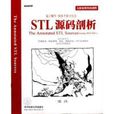集和多集
#include <set>
一個集合(set)是一個容器,它其中所包含的元素的值是唯一的。
集和多集的區別是:set支持唯一鍵值,set中的值都是特定的,而且只出現一次;而multiset中可以出現副本鍵,同一值可以出現多次。
構造
explicit set(const Compare&=compare());
如:set<int,less<int> > set1;
less<int>是一個標準類,用於形成升序排列
函式對象。降序排列是用greater<int>。
Template<class InputIterator> set(InputIterator, InputIterator,\ const Compare&=compare());
如:set<int ,less<int> >set2(vector1.begin(),vector1.end());
通過指定某一預先定義的區間來初始化set對象的
構造函式。
set(const set<Key,Compare&>);
如:set<int ,less<int> >set3(set2);
方法
clear() 清除所有元素
count() 返回某個值元素的個數
empty() 如果集合為空,返回true(真)
end() 返回指向最後一個元素之後的疊代器,不是最後一個元素
equal_range() 返回集合中與給定值相等的上下限的兩個疊代器
erase() 刪除集合中的元素
find() 返回一個指向被查找到元素的疊代器,如果沒找到則返回end()
get_allocator() 返回集合的分配器
insert() 在集合中插入元素
lower_bound() 返回指向大於(或等於)某值的第一個元素的疊代器
key_comp() 返回一個用於元素間值比較的函式
max_size() 返回集合能容納的元素的最大限值
rbegin() 返回指向集合中最後一個元素的反向
疊代器rend() 返回指向集合中第一個元素的反向疊代器
size() 集合中元素的數目
swap() 交換兩個集合變數
upper_bound() 返回大於某個值元素的疊代器
value_comp() 返回一個用於比較元素間的值的函式
集合操作
std::set_intersection() :這個函式是求兩個集合的交集。
std::set_union() :求兩個集合的並集
std::set_symmetric_difference():得到的結果是 第一個
疊代器相對於第二個的差集 並上
第二個相對於第一個的差集
struct compare{
bool operator ()(string s1,string s2){
return s1>s2;
};
std::set<string,compare> s
string str[10];
string *end = set_intersection(s.begin(),s.end(),s2.begin(),s2.end(),str,compare());//求交集,返回值指向str最後一個元素的尾端
end = std::set_union(s.begin(),s.end(),s2.begin(),s2.end(),str,compare());//並集
end = std::
set_difference(s.begin(),s.end(),s2.begin(),s2.end(),str,compare());//s2相對於s1的差集
end = std::set_difference(s2.begin(),s2.end(),s.begin(),s.end(),str,compare());//s1相對於s2的差集
end = std::set_symmetric_difference(s.begin(),s.end(),s2.begin(),s2.end(),str,compare());//上面兩個差集的並集
例子
1//////////////////////////////////////////////////////////////////
#include <iostream>
#include <set>
using namespace std;
int main(void)
{
set<int> set1;
for(int i=0; i<10; ++i)
set1.insert(i);
for(set<int>::iterator p=set1.begin();p!=set1.end();++p)
cout<<*p<<"";
if(set1.insert(3).second)//把3插入到set1中
//插入成功則set1.insert(3).second返回1,否則返回0
//此例中,集中已經有3這個元素了,所以插入將失敗
cout<<"set insert success";
else
cout<<"set insert failed";
int a[] = {4, 1, 1, 1, 1, 1, 0, 5, 1, 0};
multiset<int> A;
A.insert(set1.begin(),set1.end());
A.insert(a,a+10);
cout<<endl;
for(multiset<int>::iterator p=A.begin();p!=A.end();++p)
cout<<*p<<" ";
cin.get();
return 0;
}
2////////////////////////////////////////
#include <iostream>
#include <set>
#include <string>
#include <algorithm>
using namespace std;
struct compare
{
bool operator ()(string s1,string s2)
{
return s1>s2;
}///自定義一個仿函式
};
int main()
{
typedef std::set<string,compare> _SET;
_SET s;
s.insert(string("sfdsfd"));
s.insert(string("apple"));
s.insert(string("english"));
s.insert(string("dstd"));
cout<<"s1:"<<endl;
std::set<string,compare>::iterator it = s.begin();
while(it!=s.end())
cout<<*it++<<" ";
cout<<endl<<"s2:"<<endl;
_SET s2;
s2.insert(string("abc"));
s2.insert(string("apple"));
s2.insert(string("english"));
it = s2.begin();
while(it!=s2.end())
cout<<*it++<<" ";
cout<<endl<<endl;
string str[10];
string *end = set_intersection(s.begin(),s.end(),s2.begin(),s2.end(),str,compare());//求交集,返回值指向str最後一個元素的尾端
cout<<"result of set_intersection s1,s2:"<<endl;
string *first = str;
while(first<end)
cout <<*first++<<" ";
cout<<endl<<endl<<"result of set_union of s1,s2"<<endl;
end = std::set_union(s.begin(),s.end(),s2.begin(),s2.end(),str,compare());//並集 first = str;
while(first<end)
cout <<*first++<<" ";
cout<<endl<<endl<<"result of
set_difference of s2 relative to s1"<<endl;
first = str;
end = std::set_difference(s.begin(),s.end(),s2.begin(),s2.end(),str,compare());//s2相對於s1的差集 while(first<end)
cout <<*first++<<" ";
cout<<endl<<endl<<"result of
set_difference of s1 relative to s2"<<endl;
first = str;
end = std::set_difference(s2.begin(),s2.end(),s.begin(),s.end(),str,compare());//s1相對於s2的差集
while(first<end)
cout <<*first++<<" ";
cout<<endl<<endl;
first = str;
end = std::set_symmetric_difference(s.begin(),s.end(),s2.begin(),s2.end(),str,compare());//上面兩個差集的並集 while(first<end)
cout <<*first++<<" ";
cout<<endl;
}

